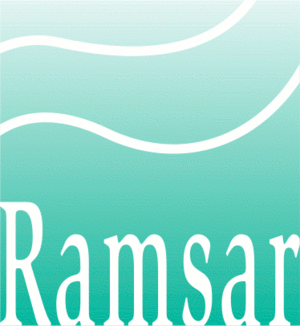Ramsar Convention facts for kids
The Ramsar Convention is an important international agreement that helps protect wetlands around the world. It's officially called "The Convention on Wetlands of International Importance, especially as Waterfowl Habitat." The main goal of this treaty is to stop wetlands from disappearing and to make sure they are used wisely for the future.
Wetlands are super important ecosystems. They have many benefits, including economic value (like for fishing), cultural value, scientific value (for studying nature), and are great for recreation (like birdwatching). The convention gets its name from the city of Ramsar in Iran, where it was first created.
Contents
What is the Ramsar Convention?
The Ramsar Convention was first discussed and agreed upon by 18 countries. This happened at a meeting in Ramsar, Iran, on February 2, 1971. The agreement officially started on December 21, 1975.
Ramsar Sites Around the World
The convention keeps a special list of important wetlands called Ramsar Sites. There are now over 1,888 of these sites, covering a huge area of about 1,853,000 square kilometers. This number has grown a lot since 2000, when there were only 1,021 sites.
The United Kingdom has the most Ramsar Sites, with 168. But Canada has the largest total area of listed wetlands, with more than 130,000 square kilometers. This includes the massive Queen Maud Gulf Migratory Bird Sanctuary, which is 62,800 square kilometers all by itself!
How the Convention Works
Currently, 159 nations have joined the Ramsar Convention. These countries meet every three years at a special event called the Conference of the Contracting Parties (COP). The very first meeting was held in Cagliari, Italy, in 1980.
Over the years, some changes have been made to the original agreement. These updates happened in Paris (1982) and Regina, Canada (1987).
The convention has a team that helps run things. This includes a standing committee, a group of scientists who review information, and a main office called the secretariat. The main office is located in Gland, Switzerland. It shares its space with the IUCN, another important group that works to protect nature.
Countries Involved in the Ramsar Convention
Many countries have joined the Ramsar Convention to help protect wetlands. Here is a list of the countries that are part of this important agreement:
- Albania
- Algeria
- Argentina
- Armenia
- Australia
- Austria
- Azerbaijan
- The Bahamas
- Bahrain
- Bangladesh
- Belarus
- Belgium
- Belize
- Benin
- Bermuda
- Bolivia
- Bosnia and Herzegovina
- Botswana
- Brazil
- Bulgaria
- Burkina Faso
- Burundi
- Cambodia
- Canada
- Chad
- Chile
- China
- Colombia
- Comoros
- Republic of the Congo
- Costa Rica
- Côte d'Ivoire
- Croatia
- Cuba
- Cyprus
- Czech Republic
- Democratic Republic of the Congo
- Denmark
- Djibouti
- Dominican Republic
- Ecuador
- Egypt
- El Salvador
- Equatorial Guinea
- Estonia
- Finland
- France
- Gabon
- The Gambia
- Georgia
- Germany
- Ghana
- Greece
- Guatemala
- Guinea
- Guinea-Bissau
- Honduras
- Hungary
- Hong Kong
- Iceland
- India
- Indonesia
- Iran
- Ireland
- Israel
- Italy
- Jamaica
- Japan
- Jordan
- Kenya
- Kyrgyzstan
- Latvia
- Lebanon
- Liberia
- Libya
- Liechtenstein
- Lithuania
- Luxembourg
- Madagascar
- Malawi
- Malaysia
- Mali
- Malta
- Mauritania
- Mauritius
- Mexico
- Moldova
- Monaco
- Mongolia
- Morocco
- Namibia
- Nepal
- Netherlands
- New Zealand
- Nicaragua
- Niger
- Nigeria
- Norway
- Pakistan
- Palau
- Panama
- Papua New Guinea
- Paraguay
- Peru
- Philippines
- Poland
- Portugal
- Republic of Macedonia
- Romania
- Russia
- Saint Lucia
- Senegal
- Serbia
- Sierra Leone
- Slovakia
- Slovenia
- South Africa
- South Korea
- Spain
- Sri Lanka
- Suriname
- Sweden
- Switzerland
- Syria
- Tajikistan
- Tanzania
- Thailand
- Togo
- Trinidad and Tobago
- Tunisia
- Turkey
- Turkmenistan
- Uganda
- Ukraine
- United Kingdom
- United States
- Uruguay
- Uzbekistan
- Venezuela
- Vietnam
- Zambia
New Countries Joining Recently
Some countries have joined the convention more recently:
- Antigua and Barbuda (2005)
- Cape Verde (2005)
- Central African Republic (2006)
- Iraq (2008)
- Kazakhstan (2007)
- Lesotho (2004)
- Marshall Islands (2004)
- Montenegro (2006)
- Mozambique (2004)
- Myanmar (2005)
- Rwanda (2006)
- Samoa (2005)
- Seychelles (2005)
- Sudan (2005)
- Turkmenistan (2009)
- United Arab Emirates (2007)
- Yemen (2008)
Images for kids
-
The Wadden Sea is a transboundary Ramsar site in Denmark, Germany and the Netherlands
See also
 In Spanish: Convenio de Ramsar para niños
In Spanish: Convenio de Ramsar para niños








